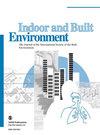Correlation of thermal environments with the bacterial concentration in bedrooms with intermittent and continuous heating modes
IF 2.9
3区 工程技术
Q2 CONSTRUCTION & BUILDING TECHNOLOGY
引用次数: 0
Abstract
Bacteria in built environments are profoundly affected by indoor thermal conditions. In China, continuous and intermittent heating modes give rise to distinct thermal environments in winter. However, the quantitative relationships between bacterial concentration and thermal conditions in the context of heating modes remain unclear. To this end, we recorded the temperature and relative humidity (RH) in 15 intermittently and 15 continuously heated residences in 27 cities across China and obtained the bacterial concentrations via the quantitative polymerase chain reaction technology. For the intermittently heated residences whose temperatures were lower than 18°C, the bacterial concentration negatively correlated with RH while the correlation was positive for those with T > 18°C. For the continuously heated residences, a quadratic correlation was found between temperature and the bacterial concentration which was highest at 23°C. For lower bacterial risk, we suggest that (1) RH in the intermittent heating region should be in the range of 40%–60% and (2) temperature in the continuous heating region should not exceed 22°C. The bacteria-adjusted thermal zones for intermittent and continuous heating are 66% and 77% of the original thermal comfort zone, respectively. Our study provides insights into the set-points of indoor thermal environments based on the microbial perspective.采用间歇式和连续式供暖模式的卧室中热环境与细菌浓度的相关性
建筑环境中的细菌深受室内热环境的影响。在中国,连续供暖和间歇供暖模式会在冬季产生不同的热环境。然而,供暖模式下细菌浓度与热环境之间的定量关系仍不清楚。为此,我们记录了全国 27 个城市中 15 个间歇供暖和 15 个连续供暖住宅的温度和相对湿度(RH),并通过定量聚合酶链反应技术获得了细菌浓度。在温度低于 18°C 的间歇供暖住宅中,细菌浓度与相对湿度呈负相关,而在温度高于 18°C 的间歇供暖住宅中,细菌浓度与相对湿度呈正相关。在持续供暖的住宅中,温度与细菌浓度之间呈二次相关,23°C 时细菌浓度最高。为降低细菌风险,我们建议:(1) 间歇供暖区域的相对湿度应在 40%-60% 之间;(2) 持续供暖区域的温度不应超过 22°C。细菌调整后的间歇供暖区和持续供暖区分别为原始热舒适区的 66% 和 77%。我们的研究从微生物的角度为室内热环境的设定点提供了启示。
本文章由计算机程序翻译,如有差异,请以英文原文为准。
求助全文
约1分钟内获得全文
求助全文
来源期刊

Indoor and Built Environment
环境科学-工程:环境
CiteScore
6.40
自引率
25.00%
发文量
130
审稿时长
2.6 months
期刊介绍:
Indoor and Built Environment publishes reports on any topic pertaining to the quality of the indoor and built environment, and how these might effect the health, performance, efficiency and comfort of persons living or working there. Topics range from urban infrastructure, design of buildings, and materials used to laboratory studies including building airflow simulations and health effects. This journal is a member of the Committee on Publication Ethics (COPE).
 求助内容:
求助内容: 应助结果提醒方式:
应助结果提醒方式:


